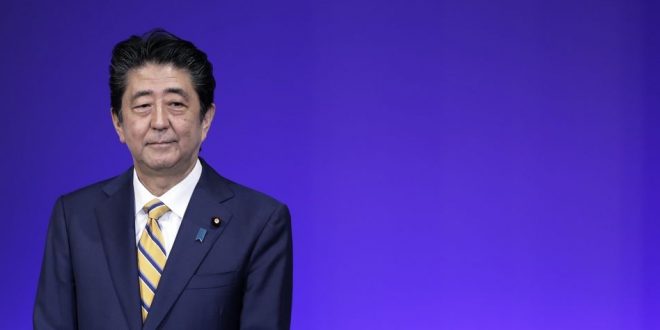Alwaght– Prime Minister Shinzo Abe of Japan is traveling to Iran to be the first Japanese leader visiting Iran after the Islamic Revolution in 1979. Although the two countries are engaged in deep-rooted relations that make it necessary for the both sides’ officials to exchange visits, Abe’s two-day trip to Tehran is largely overshadowed by the escalated tensions between Iran and the US in the Persian Gulf region. Although the efforts to de-escalate the tensions will be part of his trip plan, the achievements will never be affected by this case. The Tehran-Tokyo relations and the mutual need for expansion of the relations is the main aspect of Abe’s trip.
The news outlets, citing Japanese diplomatic sources, reported that Japan’s leader is not seeking mediation between the US and Iran in his trip and that he has no message from the US to send to the Iranian officials. The decline to mediate can be read from another aspect: despite Tokyo’s interest in de-escalation and sanctions relief that guarantee flow of energy to the Japanese Economy and allow Japanese companies’ business with Iran, Tokyo’s assessment is that it lacks the diplomatic potentials to incentivize Washington to return to the nuclear deal, lift the sanctions, and reverse the damages caused by the US withdrawal from the nuclear agreement as the Iranian preconditions to start new talks to move out of the current deadlock.
On the other side, Iran has announced that it looks at Abe’s Tehran visit solely as an instrument for the mutual ties to expand. Morteza Rahmani, Iran’s ambassador to Japan, on Sunday in an interview said that he thinks that the huge capacity of mutual cooperation and the interest of the leaders of the two countries in deepening the ties provide the drive for this visit. “So we prefer not to allow other issues to overshadow the trip. But if Japan is interested to play such a role [of mediator], we think that it should be given adequate powers by the proposing side. The Islamic Republic does not have such a proposal but it will be good to hear the viewpoints of its old friends.”
Iran-Japan relations record
The Japanese PM is visiting Tehran while the two countries this year celebrate the ninetieth anniversary of their diplomatic relationship. Their business ties were launched in 1929 with Japan opening its first trade representation office in Tehran. Shortly later, Tokyo expressed a willingness to set up diplomatic ties with Iran. The suggestion received Iranian welcome. In April 1929, the two sides signed a pact of diplomatic relations. In July 1930, Iran opened its embassy in Tokyo. Their relations went cold for nearly a decade due to the start of the Second World War. However, in 1958, they signed an agreement on economic and technologic cooperation in 1958. So, since the beginning, the economic aspect was of special significance. Japan is one of the biggest consumers of oil in the world and Iran is one of the biggest oil producers and exporters and a big consumption market. The need for Iran to develop technologically provides another drive for the two to shore up their relations.
Iran’s trade ties with Japan hiked considerably in 1960, contributing to the Japanese industrial development and improvement of living standards in Iran. Iranian-Japanese trade ties records show that raw material accounted for a majority of exported material to Japan. In addition to oil, cotton was the second top product exported to Japan especially in 1960.
In 2000, Japan negotiated with Iran over the development of Azadegan Oilfield which is assessed to contain 26 billion oil barrels. The expectations to develop the oilfield with Japan were high. But the US opposition to the cooperation foiled the bilateral talks. In 2004, Japan finally reached an agreement with National Iranian Oil to take over 75 percent of the investment in the project. But further economic sanctions on Iran frightened away the Japanese companies from the Iranian oil sector. As a result, in 2006 Japan reduced its share in the Azadegan project to 10 percent. In 2010, it fully pulled out of Iran oil industry.
Post-nuclear deal hope and fear in Iran-Japan relations
After the nuclear deal was signed in 2015 between Iran and six world powers— the US, China, Russia, Germany, Britain, and France—, this situation underwent some transformation. In 2016, a mutual pact was signed and the Japanese officials expressed interest in investing in the Iranian oil sector, car industry, railroads, and infrastructure. In 2017, Japanese imports from Iran reached $3.68 billion, on top of them oil with 98 percent and the remaining products included textile with 0.7 percent and food with 0.4 percent. Japanese exports to Iran were $906 million, including transportation facilities with 35.4 percent, general machines with 20.4 percent, and 11.4 percent in steel and metal products.
However, the growth of trade with Iran is anew affected by the new wave of anti-Iranian sanctions imposed by the US administration. When the US re-imposed the sanctions on Iran in November 2018, 5 percent of the Japanese oil was coming from Iran. Tokyo asked Washington for waivers from the embargo to continue Iran oil imports. In April, the wavers expired for Japan.
Japan, a country in favor of the nuclear deal and an opponent to Trump quitting of the nuclear deal, now looks with anxiety at the future developments in the region, where any tensions escalation will impact the energy flow to the world consumers.
 WILAYAH NEWS VOICE OF THE GLOBAL AWAKENING
WILAYAH NEWS VOICE OF THE GLOBAL AWAKENING






